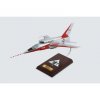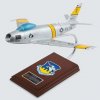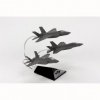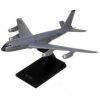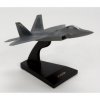McFarlane SportsPicks is no stranger to recreating some of the NBA’s greatest players as highly detailed action figures and their 20th lineup is no exception.
WARNING: CHOKING HAZARD - Small parts & small ball. Not for children under 3 years.
|
"The Joint Strike Fighter (JSF) is a joint, multinational acquisition program for the United States Air Force, Navy, Marine Corps and eight cooperative international partners. It was created to replace various aircraft while keeping development, production and operating costs down. The objective is to develop a technically superior and affordable fleet of aircraft that would be capable of a wide range of missions in a variety of theaters. On October 26, 2001, the contract was awarded to Lockheed Martin, whose X-35 experimental aircraft outperformed Boeing's X-32. The F-35 Lightning II, which is descended from the X-35, has become synonymous with the JSF program. It is a single-seat, single-engine, stealth-capable military strike fighter that can perform multiple roles such as close air support, tactical bombing and air-to-air combat. Expected to be the largest military aircraft procurement ever, the F-35 will replace a wide range of aging fighter and strike aircraft. The JSF aircraft design has three variants: conventional takeoff and landing (F-35A), short takeoff and vertical landing (F-35B), and carrier-based (F-35C). The F-35C naval variant will have a larger, folding wing and larger control surfaces for improved low-speed control, and stronger landing gear for the stresses of carrier landings. The larger wing area provides increased range and payload, with twice the range on internal fuel compared with the F/A-18C Hornet, achieving the same goal as the heavier F/A-18E/F Super Hornet. The US Navy intends to buy 480 F-35Cs to replace the Hornets. It will also serve as a stealthier complement to the Super Hornet. The F-35C is expected to be available beginning in 2012. Our F-35C Lightning II JSF/CV scale model is a faithful reproduction of the original aircraft. Handcrafted and hand-painted, it boasts of accurate details that are protected by a coat of clear lacquer. All models undergo various stages of quality control before reaching our customers. More than just a replica, it is a true work of art. The F-35C JSF/CV model aircraft is perfect as an addition to a growing collection or as an exquisite gift to a loved one. "
|
Scale: 1/40 scale model
Wing Span: 11.63
Length: 15
CF100TS
|
Scale: 1/40 scale model
Wing Span: 8.75
Length: 18
CF107AT
|
"The F-35A is the conventional takeoff and landing (CTOL) variant and is primarily used by the United States Air Force and other air forces. The F-35A is the smallest, lightest F-35 version and is the only variant equipped with an internal cannon. The F-35A can mathc the F-16 in terms of maneuverability, instantaneous and high-g performance and outperform it when it comes to stealth, range on internal fuel, avionics, operational effectiveness, supportability and survivability. It also has an internal laser designator and infrared sensors. In 2013, the A variant will be replacing the USAF's F-16 Fighting Falcons and on 2028, to replace the A-10 Thunderbolt II. "
Scale: 1/48 scale model
Wing Span: 8.75
Length: 12.75
CF035CNCCTP
|
"The North American F-86 Sabre is an American transonic jet combat aircraft developed in 1940 and was one of the most-produced Western jet fighters of the Cold War era. In 1949, the F-86 entered service with the United States Air Force, joining the 1st Fighter Wing's 94th Fighter Squadron ""Hat-in-the-Ring"" and became the primary air-to-air jet fighter used in the Korean War. F-86 pilots were credited to have shot down 792 MiGs with a loss of only 78 Sabres, a victory ratio of 10:1. Among the first recipients of surplus USAF Sabres was the Republic of China Air Force of Taiwan. In one month of air battles over Quemoy and Matsu, Nationalist pilots tallied a score of no less than 29 MiGs destroyed and eight probables. In 1954, the F-86 entered service with the Pakistan Air Force with the first batch of 120 aircraft. Pakistan Air Force F-86 Flying Ace Squadron Leader Muhammad Mahmood Alam officially credited with five kills in air-to-air combat and destroyed five more enemy Hunter aircraft in less than a minute. Mahmood Alam had a total of nine kills and two damaged to his credit. At the beginning of the war, Pakistani Air Force had eight squadrons of F-86 Sabres. The F-86s downed 31 Indian aircraft in air-to-air-combat. After the war, Pakistan slowly phased out the F-86 Sabres and replaced them with Chinese F-6 fighters. In 1980, the last of the Sabres were withdrawn from service in Pakistan Air Force. The F-86 are currently displayed in Pakistan Air Force Museum and in the cities to which their pilots lived. The F-86F is furnished with the J47-GE-27 engine with about 700 additional pounds of thrust, which increased its top speed about 15 mph to 695 mph. Combat range was increased from 660 miles to 923 miles. It was the first Sabre to haul a 1,200 lb. nuclear bomb , which was carried under the port wing. The F-86F was also furnished with a LABS which allowed the aircraft to escape the blast."
Scale: 1/48 scale model
Wing Span: 9.25
Length: 9.5
CF086FT
|
"The North American F-86 Sabre is an American transonic jet combat aircraft developed in the late 1940s and was considered the most produced Western jet fighters of the Cold War era. The F-86 was produced as both a fighter-interceptor and fighter-bomber and several variants were introduced, with improvements and different armament implemented. Inn 1949, the F-86 entered service with the United States Air Force, joining the 1st Fighter Wing's 94th Fighter Squadron ""Hat-in-the-Ring"" and it became the primary air-to-air jet fighter in the Korean War. Recent USAF records show that 224 F-86s were lost to all causes, including non-combat losses. Only one USAF pilot had flown the F-86 Sabre of the 40 other pilots earned the designation of ace during the Korean War. In 1954, 120 F-86 entered service with the Pakistan Air Force and it became the mainstay of the PAF and provided a qualitative edge against a larger Indian Air Force. During the Indo-Pakistani was of 1965, the PAF claimed to have shot sown 15 IAF aircraft, having a loss of 14 combat aircraft to the PAF's F-86s. During the Indo-Pakistani war in 1971, PAF had eight squadrons of F-86 Sabres and it performed well, downing 31 Indian aircraft in air-to-air combat, with a loss of seven F-86s. After the war, Pakistan replaced the F-86 Sabres with Chinese F-6 (Russian MiG-19) fighters and the remaining Sabres were withdrawn from service in 1980. The primary users of the F-86 are the United States Air Force, Pakistan Air Force and Portuguese Air Force. There are 9,680 F-86s built with 2,239 F-86Fs built. "
Scale: 1/32 scale model
Wing Span: 14.13
Length: 13.75
CF086TE
|
"The Northrop F-89 Scorpion is a twin-engine, all-weather fighter-interceptor designed to locate, intercept, and destroy enemy aircraft by day or night under all types of weather conditions. One of the most heavily armed fighter aircraft, it was the backbone of the United States Air Force's (USAF) Air Defense Command (ADC) for over 17 years, helping patrol the skies during the period when Soviet intercontinental bombers first became a threat. The F-89 was the first aircraft armed with nuclear weapons (the MB-1 Genie rocket) for air-to-air use. The Scorpion was a result of a 1945 US Army Air Forces specification for a jet-powered night fighter to replace the P-61 Black Widow. It was the first multi-seat, all-weather jet interceptor and the first aircraft designed to carry an all-rocket armament. Its advanced radar system was capable of tracking and engaging hostile bombers in any weather. A unique feature added to the prototype during development was the deceleron, a two-part aileron that could split open to act as an air brake. This feature became Northrop's trademark and is still being used today, as can be seen on the B-2 Spirit. The F-89's name came from its resemblance to a scorpion ready to strike. The name stuck and was later officially recognized by the Air Force. The aircraft made its maiden flight on August 16, 1948. The first production F-89A was accepted by the USAF on September 28, 1950. Only eight aircraft were completed before the type was upgraded to the F-89B, with new avionics. Unfortunately, these had considerable problems with engines and other systems, and soon gave way to the F-89C. The first major production model was the F-89D, which first flew on October 23, 1951 and entered service in 1954. On July 19, 1957, a Genie test rocket was fired from an F-89J, the first time in history that an air-to-air rocket with a nuclear warhead was launched and detonated. There were no new-build F-89Js, but 350 F-89Ds were modified to this standard. These served with the ADC through 1959 and with the Air National Guard through 1969. "
Scale: 1/48 scale model
Wing Span: 15.5
Length: 13.5
CF089T
|
"The North American F-100 Super Sabre, affectionately known as “The Hun”, was a jetfighter aircraft that served with the United States Air Force (USAF) from 1954 to 1971 and with the Air National Guard (ANG) until 1979. The F-100 is one of those classics that rely on sheer power and good looks. F-100 Super Sabre first flew on May 25, 1953. The F-100D model of the Super Sabre was single-seat fighter-bomber, more advanced avionics, larger wing and tail fin, landing flaps. The F-100D first flew on January 24 1956, piloted by Dan Darnell. Late production models of the F-100D had the capability of being launched from remote areas in the manner of manned missiles. An F-100D Super Sabre became the first supersonic aircraft to be ""boosted"" airborne without use of a runway in successful Zero Length Launch (ZEL) tests at Edwards Air Force Base, California, in 1958. The F-100D Super Sabre featured many additional capabilities needed by the USAF, including a flapped wing, provisions for internal Electronic Counter-Measures (ECM) equipment and introduction of a Low-Altitude Bombing System (LABS). A total of 1,274 F-100D Super Sabre were built. One of these aircrafts is preserved at the Carolinas Aviation Museum. "
Scale: 1/48 scale model
Wing Span: 10
Length: 12.5
CF100T
|
"The F-111 is a twin-engine swing-wing aircraft which can take-off and land at relatively low speeds with the wings swept forward and can fly close to the ground a supersonic speeds. The General Dynamics F-111 is an American medium-range strategic bomber, reconnaissance and tactical strike aircraft designed in the 1960s. On July 27, 1996, the F-111 was officially named as Aardvark. The F-111 was affectionately called the ""Pig"". The F-111A was the initial production version of the F-111. It incorporates TF30-P-3 engines with 12,000 lbf dry and afterburning thrust and ""Triple Plow I"" variable intakes. There's a 158 total production of the F-111A, including 17 preproduction aircraft that were later brought up to production standards. In 1977, the remaining F-111As were transferred to the 366 TFW based at Mountain Home AFB, equipping the 389th, 390th and 391st TFS. There were four F-111As converted to F-111C standard and provided to Australia as attrition replacements. Some of the F-111As delivered to the Royal Australian Air Force were Vietnam veterans. In USAF service, the F-111 was replaced by the F-15E Strike Eagle for medium-range precision strike missions. In 2010, the Royal Australian Air Force will replace its F-111s with 24 F/A-18F Super Hornets. "
Scale: 1/48 scale model
Wing Span: 10
Length: 18.5
CF111TR
|
"The F-117 Black Jet, also known as the “Nighthawk”, was manufactured by Lockheed Martin. The F-117 was built to be used by the U.S Air Force. The U.S decided to develop a full-scale, radar-evading fighter. The F-117 had its first flight in June 1981. The F-117A, a Black Jet variant, may look as if it were built for use by alien beings, but it is actually flown by flesh-and-blood humans like Capt. Phil McDaniel, a pilot with the 37th Tactical Fighter Wing. Any way you look at it, the F-117A is an unusual aircraft. Its design and development were also out of the ordinary. The F-117A is equipped with sophisticated navigation and attack systems integrated into a digital avionics suite. It carries no radar, which lowers emissions and cross-section. It navigates primarily by GPS and high-accuracy inertial navigation. Missions are coordinated by an automated planning system that can automatically perform all aspects of a strike mission, including weapons release. Targets are acquired by a thermal imaging infrared system, slaved to a laser that finds the range and designates targets for laser-guided bombs. "
Scale: 1/72 scale model
Wing Span: 6.63
Length: 11
CF117TP
|
This great collection spans the history of the Blue Angels. Mounted on a beautiful mahogany base all eight model aircrafts are precisely hand finished to exact detail, from F-6F Hellcat to the currently used F/A-18 Hornet. Complete with the Blue Angels logo and brass plaques indicating the aircraft type and years flown.
Scale: 1/72 scale model
Wing Span: 36
Length: 13
CFBAC
Pre-Order! Available: November
|
|
|
"The Boeing KC-135 Stratotanker is the only aerial refueling tanker and transport aircraft. The aircraft can also carry passengers or cargo as all the refueling equipment is below the main cabin deck. KC-135 made its first flight on August 17, 1956. The KC-135 served in combat during the Vietnam Conflict and Desert Storm. It also provided refueling support for many operations, both military and humanitarian, such as Operation Restore Hope in Somalia. It has been in service with the U.S. Air Force since 1957 and still serves as the backbone of America's tanker fleet. The KC-135A variant first flew on August 31, 1956 and the initial production Stratotanker was delivered to Castle Air Force Base, Calif., in June 1957. The KC-135A entered service with the U.S. Air Force on 28 June 1957. The last KC-135 was delivered to the Air Force in 1965. Of the original KC-135A's, more than 410 have been modified with new CFM-56 engines produced by CFM-International. The re-engined tanker, designated either the KC-135R or KC-135T, can offload 50 percent more fuel, is 25 percent more fuel efficient, costs 25 percent less to operate and is 96 percent quieter than the KC-135A. "
Scale: 1/100 scale model
Wing Span: 16
Length: 16.5
CK135AT
|
"The F-22 Raptor is the newest fighter aircraft of the United States Air Force (USAF). Originally an air superiority fighter for use against the Soviet Air Force, it is also capable of ground attack, electronic warfare and signals intelligence roles. The F-22 is a combination of stealth, supercruise, maneuverability, integrated avionics and improved supportability. It performs both air-to-air and air-to-ground missions, making it vital to the USAF. The Raptor is capable of providing first-kill opportunities against threats. Its sophisticated aerodesign, advanced flight controls, thrust vectoring and high thrust-to-weight ratio provide the capability to outmaneuver all current and projected aircraft. Intended to be the leading American advanced tactical fighter in the early part of the 21st century, the Raptor is the world's most expensive fighter to date. The F-22 was born out of the Advanced Tactical Fighter (ATF) demonstration and validation program to develop a next-generation air superiority fighter to counter emerging worldwide threats, inlcuding development and proliferation of Soviet-era Su-27 Flanker type aircraft. In 1981, the Air Force put out a requirement for a new air superiority fighter that would replace the capability of the F-15 Eagle, incorporating emerging technologies such as advanced alloys, fly-by-wire flight control systems and stealth technology. In October 1986, two contractor teams, Lockheed/Boeing/General Dynamics and Northrop/McDonnell Douglas, were selected to build prototypes. In August 1991, after a fly-off competition, Lockheed's YF-22 was declared the winner and the company was awarded the contract to produce the ATF. "
Scale: 1/72 scale model
Wing Span: 7.5
Length: 10.13
CF0222TR
|




